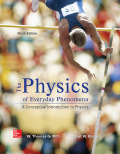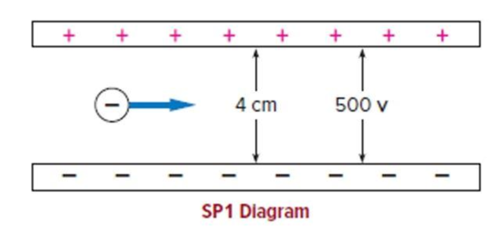
Concept explainers
An electron beam in a cathode-ray tube passes between two parallel plates that have a voltage difference of 500 V across them and are separated by a distance of 4 cm. as shown in the following diagram.
a. In what direction will the electron beam deflect as it passes between these plates? Explain.
b. Using the expression for a uniform field. ΔV = Ed, find the value of the electric field in the region between the plates.
c. What is the magnitude of the force exerted on individual electrons by this field? (F = qE, q = 1.6 × 10–19C)
d. What are the magnitude and direction of the acceleration of an electron? (m = 9.1 × 10–31 kg)
e. What type of path will the electron follow as it passes through the region between the plates? Explain.

(a)
The direction in which the electron beam will deflect as is passes between the plates.
Answer to Problem 1SP
The electron beam will deflect upward.
Explanation of Solution
Electron is the first discovered fundamental particles. It was discovered by J. J. Thomson in 1897. The mass of electron is
Electrons are negatively charged particles. The magnitude of the charge of electron is
One of the fundamental property of the electric charges is that the like charges repel whereas the unlike charges attract. Thus it will be attracted towards the upward plate which has positive charge. In another way, the direction of the electric field is from positive to negative and the force on a negative charge is opposite to the direction of electric field. This implies the force on the electron is towards the positive plate.
Conclusion:
Thus the electron beam will deflect upward.
(b)
The value of the electric field in the region between the plates.
Answer to Problem 1SP
The value of the electric field in the region between the plates is
Explanation of Solution
Given Info: The distance between the plates is
Write the equation for the electric field between the plates.
Here,
Substitute
Conclusion:
Thus the value of the electric field in the region between the plates is
(c)
The magnitude of the force exerted on individual electron by the electric field.
Answer to Problem 1SP
The magnitude of the force exerted on individual electron by the electric field is
Explanation of Solution
Write the equation for the magnitude of the force on the electron.
Here,
The magnitude of
Substitute
Conclusion:
Thus the magnitude of the force exerted on individual electron by the electric field is
(d)
The magnitude and direction of the acceleration of an electron.
Answer to Problem 1SP
The magnitude of acceleration of an electron is
Explanation of Solution
Write the equation for the force on a body.
Here,
Rewrite the above equation for
Substitute
The direction of acceleration will be in the direction force on the particle. In part (b) it is found that the force on the particle is toward upward so that the direction of acceleration will also be upward.
Conclusion:
Thus the magnitude of acceleration of an electron is
(e)
The type of path the electron will follow as it passes through the region between the plates.
Answer to Problem 1SP
The type of path the electron will follow as it passes through the region between the plates will be parabolic and it will be towards the positively charged plate.
Explanation of Solution
The path followed by a particle under the action of given forces is called the trajectory of the particle. The trajectory may have different shapes. It can be expressed by a particular equation.
In the given situation, the electrons are in a uniform electric field between the plates. This implies the electron will have constant acceleration. This is similar to the situation where a body is under the influence of gravitational force where the constant acceleration is equal to the acceleration due to gravity.
A body falling under gravitational force will follow a parabolic path. Similarly the electron moving with the constant acceleration will also follow a parabolic path and it will be directed towards the positive plate situated upward.
Conclusion:
Thus the type of path the electron will follow as it passes through the region between the plates will be parabolic and it will be towards the positively charged plate.
Want to see more full solutions like this?
Chapter 18 Solutions
Physics of Everyday Phenomena
- A circular coil with 100 turns and a radius of 0.05 m is placed in a magnetic field that changes at auniform rate from 0.2 T to 0.8 T in 0.1 seconds. The plane of the coil is perpendicular to the field.• Calculate the induced electric field in the coil.• Calculate the current density in the coil given its conductivity σ.arrow_forwardAn L-C circuit has an inductance of 0.410 H and a capacitance of 0.250 nF . During the current oscillations, the maximum current in the inductor is 1.80 A . What is the maximum energy Emax stored in the capacitor at any time during the current oscillations? How many times per second does the capacitor contain the amount of energy found in part A? Please show all steps.arrow_forwardA long, straight wire carries a current of 10 A along what we’ll define to the be x-axis. A square loopin the x-y plane with side length 0.1 m is placed near the wire such that its closest side is parallel tothe wire and 0.05 m away.• Calculate the magnetic flux through the loop using Ampere’s law.arrow_forward
- Describe the motion of a charged particle entering a uniform magnetic field at an angle to the fieldlines. Include a diagram showing the velocity vector, magnetic field lines, and the path of the particle.arrow_forwardDiscuss the differences between the Biot-Savart law and Coulomb’s law in terms of their applicationsand the physical quantities they describe.arrow_forwardExplain why Ampere’s law can be used to find the magnetic field inside a solenoid but not outside.arrow_forward
- 3. An Atwood machine consists of two masses, mA and m B, which are connected by an inelastic cord of negligible mass that passes over a pulley. If the pulley has radius RO and moment of inertia I about its axle, determine the acceleration of the masses mA and m B, and compare to the situation where the moment of inertia of the pulley is ignored. Ignore friction at the axle O. Use angular momentum and torque in this solutionarrow_forwardA 0.850-m-long metal bar is pulled to the right at a steady 5.0 m/s perpendicular to a uniform, 0.650-T magnetic field. The bar rides on parallel metal rails connected through a 25-Ω, resistor (Figure 1), so the apparatus makes a complete circuit. Ignore the resistance of the bar and the rails. Please explain how to find the direction of the induced current.arrow_forwardFor each of the actions depicted, determine the direction (right, left, or zero) of the current induced to flow through the resistor in the circuit containing the secondary coil. The coils are wrapped around a plastic core. Immediately after the switch is closed, as shown in the figure, (Figure 1) in which direction does the current flow through the resistor? If the switch is then opened, as shown in the figure, in which direction does the current flow through the resistor? I have the answers to the question, but would like to understand the logic behind the answers. Please show steps.arrow_forward
- When violet light of wavelength 415 nm falls on a single slit, it creates a central diffraction peak that is 8.60 cm wide on a screen that is 2.80 m away. Part A How wide is the slit? ΟΙ ΑΣΦ ? D= 2.7.10-8 Submit Previous Answers Request Answer × Incorrect; Try Again; 8 attempts remaining marrow_forwardTwo complex values are z1=8 + 8i, z2=15 + 7 i. z1∗ and z2∗ are the complex conjugate values. Any complex value can be expessed in the form of a+bi=reiθ. Find θ for (z1-z∗2)/z1+z2∗. Find r and θ for (z1−z2∗)z1z2∗ Please show all stepsarrow_forwardCalculate the center of mass of the hollow cone shown below. Clearly specify the origin and the coordinate system you are using. Z r Y h Xarrow_forward
 College PhysicsPhysicsISBN:9781938168000Author:Paul Peter Urone, Roger HinrichsPublisher:OpenStax College
College PhysicsPhysicsISBN:9781938168000Author:Paul Peter Urone, Roger HinrichsPublisher:OpenStax College Physics for Scientists and Engineers with Modern ...PhysicsISBN:9781337553292Author:Raymond A. Serway, John W. JewettPublisher:Cengage Learning
Physics for Scientists and Engineers with Modern ...PhysicsISBN:9781337553292Author:Raymond A. Serway, John W. JewettPublisher:Cengage Learning Physics for Scientists and EngineersPhysicsISBN:9781337553278Author:Raymond A. Serway, John W. JewettPublisher:Cengage Learning
Physics for Scientists and EngineersPhysicsISBN:9781337553278Author:Raymond A. Serway, John W. JewettPublisher:Cengage Learning Modern PhysicsPhysicsISBN:9781111794378Author:Raymond A. Serway, Clement J. Moses, Curt A. MoyerPublisher:Cengage Learning
Modern PhysicsPhysicsISBN:9781111794378Author:Raymond A. Serway, Clement J. Moses, Curt A. MoyerPublisher:Cengage Learning Principles of Physics: A Calculus-Based TextPhysicsISBN:9781133104261Author:Raymond A. Serway, John W. JewettPublisher:Cengage Learning
Principles of Physics: A Calculus-Based TextPhysicsISBN:9781133104261Author:Raymond A. Serway, John W. JewettPublisher:Cengage Learning





